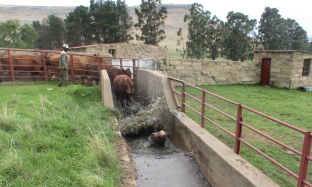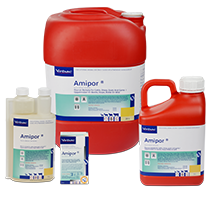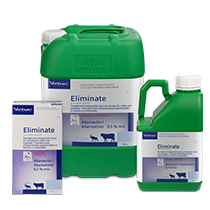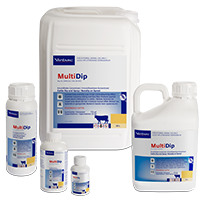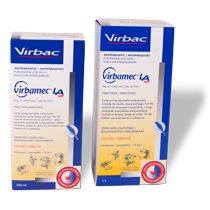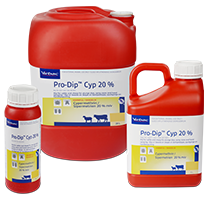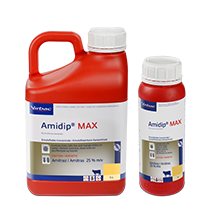Efficient Tick Control – “The Basics”
Ticks are economically the most significant external parasites of livestock. Heavy infestations cause direct harm (blood loss, a reduced rate of live weight gain, a lower milk yield, and a degradation of hide quality) and indirect harm (tick-borne diseases such as redwater, heartwater, anaplasmosis, and sweating sickness).
Efficient tick control enables profitable stock farming. Without it, it would probably have been impossible to farm with cattle in many regions of South Africa where high tick populations of single- and multi-host ticks occur.
To plan a complete external parasite control strategy, farmers need to know all the information available for their farms on the following:
- The parasite.
- Seasonal occurrence.
- Product choice.
- Tick-control regime.
The Parasite:
In South Africa, 85 Ixodidae (hard) tick species and 21 Argasidae (soft) tick species have been identified. The following are of economic importance to livestock farmers:
- Blue ticks.
- Red-legged ticks.
- Bont-legged ticks.
- Brown-ear ticks.
- Karoo paralysis tick.
- Bont ticks.
They all have different lifecycles and anything from one host up to three. The lifecycle has four distinct stages of development: egg, larva, nymph, and adult. Depending on the tick species, the different stages can survive in the veld for between six and eight months without a host.
To distinguish between the different species, one needs to look at their size, mouthparts, and the patterns/colouring on their legs and bodies. All the engorged female ticks may appear to look the same from a distance (blue-grey in colour) and can all be mistaken for blue ticks.
If you have identified all the different tick species that occur on your farm, you can adapt your dipping methods and frequency to reduce their numbers, which help to reduce tick-borne disease outbreaks and the mechanical damage they cause.
Seasonal occurrence
Knowledge on the seasonal occurrence of a tick species identified on the farm is an important factor in the successful control of external parasites by reducing the ticks’ numbers, for example:
-
One-host ticks: Although tick numbers might still be low between October and December, farmers need to implement a strategic dipping programme during these months to reduce the high tick populations that will occur from February to May. To put this into perspective; every engorged female blue tick lays between 2500 and 3500 eggs. If only 200 ticks survive and lay eggs from October to December, more than 400 000 tick larvae will hatch in the next 30 to 60 days. By reducing the early-summer peak (reducing the number of females that can lay eggs), we reduce the late-summer peak. During the months of February to May, dip intervals may have to be shortened where needed to reduce the high number of ticks.
- Multi-host ticks: To reduce the damage caused by multi-host ticks (red-legged, bont-legged, and brown-ear ticks), farmers have to implement a strategic winter-dipping programme during July/August to reduce the number of larvae on the animals. Follow-up treatments will be needed during the peak-summer months of November/December. Dip intervals can be shortened where high numbers of ticks occur.
Product choice and tick-control regime:
A number of products available in the form of either a pour-on, dip (spray race/plunge dip), or injectable are available with different trade names. These products represent five chemical groups: organophosphates, synthetic pyrethroids (i.e. cypermethrin), formamidines (i.e. amitraz), macrocyclic lactones (i.e. ivermectin), and chitin synthesis inhibitors or growth regulators. The product and method of choice will depend on the type of ticks that occur on your farm and the number of animals that need to be dipped:
- Pour-on is easy to apply but generally more expensive. It is cost-effective when animals are only treated three to four times per year and are also used for winter treatments.
- Spray race is very effective, especially when tick numbers are high. With a spray race, the active ingredients can be changed often to prevent resistance in areas where animals are dipped regularly. Care must be taken to ensure that the animals are properly soaked.
- Plunge dip is the most efficient and cost-effective dip method when you have large herds that need to be dipped regularly. The plunge dip must be properly managed to ensure effective dipping.
- Injectables and insect-growth regulators need to be part of the tick-control strategy in areas of abundant ticks as a way to change active ingredients and help with tick management. These must always be used in conjunction with contact-dip remedies as described above.
Other factors to consider with a tick-control strategy:
-
Animal:
- Type of breed and coat (long/short hair): Bos indicus / short-haired breeds are more suitable for the high-tick areas. With Bos taurus / long-haired breeds, dipping intervals generally need to be shorter.
- Age, immune status, and stress levels of animals: With high stress levels and low immunity levels, animals are more susceptible to tick-borne diseases.
- Closed/open herd: When you buy animals from other areas, dip them before introducing them into the herd.
-
Environment:
- Rainfall and temperature: Rain and high humidity and temperatures are favourable conditions for tick populations to increase.
- The length of the grass: Long, wet grass can wipe dip off the animals and reduce its efficacy. Long grass can also contribute to higher tick numbers.
- The size of the property and the presence of wildlife: On extensive, low-density farms, tick numbers should be lower. Wildlife can be preferred hosts for multi-host ticks and could contribute to the tick numbers on the farm.
-
Management:
-
The previous tick-control and -resistance history of the farm, total/tactical strategic tick control, the use of vaccines against tick-borne diseases, and movement of animals to rested camps: All this information should be considered when deciding which control method(s) and product(s) to use on a specific farm to ensure effective control.
-
60092309CM

